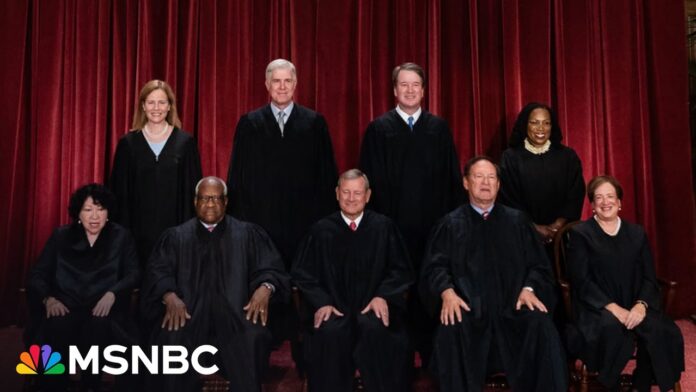The ruling by the Supreme Court’s conservative majority challenges the Trump administration’s restrictions on rapid-fire gun accessories used in the Las Vegas mass shooting
The Supreme Court on Friday struck down a Trump-era ban on bump stocks, the rapid-fire gun accessories used in the deadliest mass shooting in modern U.S. history, at a country music festival in Las Vegas. This decision, which reopens a contentious political debate, found that the Trump administration overstepped its authority by implementing the ban without congressional approval.
The 6-3 decision, authored by Justice Clarence Thomas, concluded that the Justice Department incorrectly classified bump stocks as transforming semiautomatic rifles into illegal machine guns. Thomas argued that since each trigger pull still results in a single shot, bump stocks do not fit the definition of machine guns under federal law.
The ruling comes as firearms and gun control are once again thrust into the political spotlight. Democrats have condemned the decision, citing the potential for increased gun violence, while many Republicans have supported the court’s interpretation of executive overreach.
President Joe Biden, a proponent of gun restrictions, urged Congress to reinstate the bump stock ban, emphasizing the need for legislative action to ensure lasting policy. In contrast, former President Donald Trump, who had implemented the ban during his administration, downplayed the significance of his prior action and reiterated his support for gun owners’ rights.
The decision highlights the limitations of executive authority in regulating firearms, with both conservative and liberal justices suggesting that a bipartisan legislative approach could offer a more durable solution. The initial ban was enacted through regulation, which spared congressional Republicans from the political fallout of passing new gun control measures in the wake of the Las Vegas massacre and the Parkland school shooting.
The 2017 Las Vegas shooting saw a gunman use bump stocks to fire over 1,000 rounds in 11 minutes, killing 60 people and wounding hundreds more. The Supreme Court’s ruling has reignited painful memories for the victims’ families, with some expressing deep disappointment and concern over the potential for future tragedies.
Justice Sonia Sotomayor, in her dissent joined by the court’s liberal justices, argued that bump stocks effectively turn semiautomatic weapons into machine guns and warned that the ruling could have “deadly consequences.” She criticized the majority’s interpretation, stating that bump stocks allow for continuous rapid fire that mimics the function of machine guns.
The ATF, under the Trump administration, had reversed earlier decisions made during the Bush and Obama administrations that did not classify bump stocks as machine guns. The high court’s decision underscores the need for clear legislative definitions to avoid inconsistent regulatory interpretations.
Despite the Supreme Court’s ruling, sixteen states and the District of Columbia maintain their own bans on bump stocks, although four state bans may no longer be enforceable, according to the gun-control group Everytown for Gun Safety.
Texas gun shop owner and military veteran Michael Cargill, who challenged the ban, celebrated the ruling, predicting it would impact other ATF regulations on firearms. The New Civil Liberties Alliance, representing Cargill, argued that while bump stocks enable rapid fire, they require more effort from the shooter compared to fully automatic weapons.
The Biden administration defended the ban, asserting that the ATF’s detailed examination post-Las Vegas shooting rightly concluded bump stocks should be classified as machine guns. The 2019 ban affected an estimated 520,000 bump stocks, which were either surrendered or destroyed, resulting in significant financial losses for owners.
This ruling, following a 2022 landmark decision expanding gun rights, sets the stage for another impending Supreme Court decision on a federal law restricting gun possession by individuals under domestic violence restraining orders, further keeping firearms regulation at the forefront of national debate.
Analysis:
Political:
The Supreme Court’s decision highlights the ongoing tension between executive authority and legislative action in gun control policy. The ruling challenges the Trump administration’s regulatory approach, pushing the responsibility back to Congress. This decision underscores the deep political divisions on gun control, with potential implications for future legislative efforts and electoral dynamics.
Social:
Socially, the ruling has significant implications, potentially influencing public perception of gun control and safety. Victims’ families and gun control advocates express concerns about increased gun violence, while supporters of gun rights view the decision as a victory for individual liberties. The decision may fuel public debate on the balance between safety and constitutional rights.
Economical:
Economically, the ruling could impact the firearms market, particularly for bump stocks and similar accessories. The reinstatement of bump stocks may lead to renewed sales and manufacturing, but also raises concerns about potential liability and insurance costs associated with mass shootings. The financial impact on those who surrendered or destroyed bump stocks following the 2019 ban also remains a contentious issue.
Technological:
Technologically, the decision underscores the challenges in regulating firearms accessories that enhance weapon capabilities. It raises questions about future regulatory approaches to rapidly evolving firearm technologies and the balance between innovation and public safety. The ruling may prompt further advancements in firearm modifications and accessories, complicating regulatory efforts.
Environmental:
From an environmental perspective, the decision has limited direct impact. However, increased firearm usage and manufacturing could have indirect environmental consequences, such as resource consumption and waste generation. The broader implications for public safety and community stability also have environmental considerations, particularly in urban and densely populated areas.
